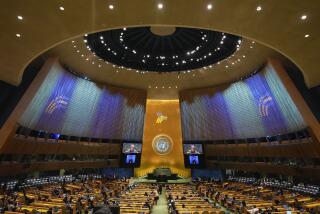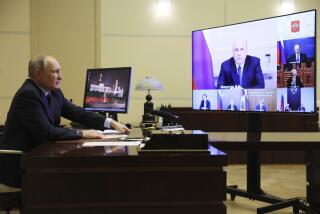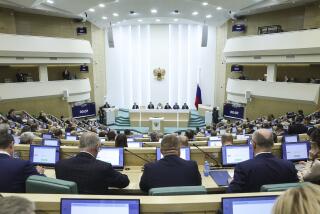An Amended Nuclear Pact Holds Hope of Total Ban
- Share via
Twenty-five years ago today the United States, Great Britain and the Soviet Union signed the partial nuclear-test-ban treaty.
This treaty banned all nuclear testing except underground. And although this left a big loophole, the treaty nevertheless was hailed as a breakthrough and the first step toward ending the nuclear-arms race.
The three signatory nuclear powers promised that they would seek to end “all test explosions of nuclear weapons for all time”--a promise repeated in the 1968 nuclear non-proliferation treaty in which the parties also undertook to negotiate a “cessation of the nuclear-arms race at an early date.”
Over the years that goal has suffered many setbacks, and the hopes for a total test ban and for halting the nuclear-arms race have faded. But as a result of some recent developments there is renewed hope for major progress.
Nearly all non-nuclear states regard a comprehensive, meaning total, nuclear-test ban as the single most important step toward halting and reversing the nuclear-arms race. They fear that without such a total ban, even “deep cuts” in the numbers of these weapons could be nullified by qualitative improvements, resulting in a situation in which less is more.
Meanwhile, the two superpowers continue to test and develop new nuclear weapons with no end in sight. Non-nuclear states believe that they were misled, and they feel frustrated and cheated. They were shocked by the U.S.-Soviet agreement of September, 1987, to begin bilateral, long-term negotiations on nuclear testing and verification. While these talks are going on, continued testing is permitted.
A total test ban is the “ultimate” objective of a process leading to the “ultimate” elimination of nuclear weapons. As various American officials have volunteered, nuclear testing would continue well into the 21st Century.
A group of non-nuclear countries concluded that the time had come to take matters into their own hands. They proposed that the United Nations support a move to amend the partial-test-ban treaty to ban all tests. Under the treaty, any party may propose amendments, and if one-third (39 nations) support an amendment the governments of the United States, Great Britain and the Soviet Union must convene a conference to consider it.
In November, 1987, the United Nations recommended that the non-nuclear parties formally submit a proposal to convert the partial ban into a total test ban. One hundred twenty-eight countries, including the Soviet Union, voted for the recommendation; the United States, Great Britain and France (which is not a party to the treaty) were the only countries that voted against it.
The amendment procedure may be initiated by a formal proposal today, the treaty’s anniversary.
If an amendment conference is convened, there is still a difficult task ahead. Any amendment must be approved by a majority of the parties to the partial-test-ban treaty (58), including the three signatory governments. Thus the United States and Great Britain could still withhold approval or ratification and prevent the amendment from coming into force. Onthe other hand, if they did agree and the amendment was ratified, it would become automatically binding on all parties.
The backers of the amendment believe that the ongoing multilateral negotiations for a total test ban would create strong pressures on both Washington and London to adopt a more positive attitude.
The non-proliferation treaty must be reviewed in 1990 and its future decided in 1995. If the nuclear parties to the partial-test-ban treaty will not agree to stop testing, the existence of the non-proliferation treaty might be put into jeopardy.
Yet there are strong positive incentives that would make an amendment for a total test ban the best way to curb nuclear proliferation. Argentina, Brazil, India, Israel, Pakistan and South Africa--all of which are or will soon be able to “go nuclear”--are not parties to the non-proliferation treaty. All of them, however, are parties to the partial-test-ban treaty and would be barred from testing if the amendments were ratified.
These countries would therefore have little incentive to produce a stockpile of untested nuclear weapons. The nuclear powers, which even now argue that they must test to ensure the reliability of their current weapons, would also have less incentive to develop new ones.
The amendment conference thus points the way toward ending the production of new nuclear weapons, which has for far too long fueled the nuclear-arms race and encouraged the further proliferation of these weapons.
More to Read
Sign up for Essential California
The most important California stories and recommendations in your inbox every morning.
You may occasionally receive promotional content from the Los Angeles Times.













